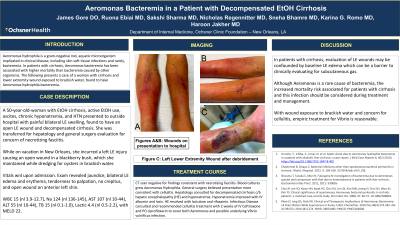Tuesday Poster Session
Category: Liver
P3982 - Aeromonas Bacteremia in a Patient With Decompensated EtOH Cirrhosis
Tuesday, October 24, 2023
10:30 AM - 4:00 PM PT
Location: Exhibit Hall

Has Audio

James Gore, DO
Ochsner Clinic Foundation
New Orleans, LA
Presenting Author(s)
James Gore, DO, Ruona Ebiai, MD, Sakshi Sharma, MD, Nicholas Regennitter, MD, Sneha Bhamre, MD, Karina Romo, MD, Haroon Jakher, MD
Ochsner Clinic Foundation, New Orleans, LA
Introduction: Background: Aeromonas hydrophila is a gram-negative rod, aquatic microorganism implicated in clinical disease, including skin soft tissue infections and rarely, bacteremia. In patients with cirrhosis, Aeromonas bacteremia has been associated with higher mortality than bacteremia caused by other organisms. The following presents a case of a woman with cirrhosis and lower extremity wound exposed to brackish water, found to have Aeromonas hydrophila bacteremia.
Case Description/Methods: Clinical Case: A 50-year-old-woman with EtOH cirrhosis, active EtOH use, ascites, chronic hyponatremia, and HTN presented to outside hospital with painful bilateral LE swelling, found to have an open LE wound and decompensated cirrhosis. She was transferred for hepatology and general surgery evaluation for concern of necrotizing fasciitis. While on vacation in New Orleans, she incurred a left LE injury causing an open wound in a blackberry bush, which she maintained while dredging for oysters in brackish water. Vitals wnl upon admission. Exam revealed jaundice, bilateral LE edema and erythema, tenderness to palpation, no crepitus, and open wound on anterior left shin. WBC 15 (nl 3.9-12.7), Na 124 (nl 136-145), AST 107 (nl 10-44), ALT 55 (nl 10-44), TB 15 (nl 0.1-1.0), Lactic 4.4 (nl 0.5-2.2), with MELD 22. CT scan negative for findings consistent with necrotizing fasciitis. Blood cultures grew Aeromonas Hydrophila. General surgery believed presentation more consistent with cellulitis. Hepatology consulted for decompensated cirrhosis c/b hepatic encephalopathy (HE) and hyponatremia. Hyponatremia improved with IV albumin and lasix. HE resolved with lactulose and rifaxamin. Infectious Disease consulted and recommended cellulitis treatment with 2 weeks of IV Ceftriaxone and PO ciprofloxacin to cover both Aeromonas and possible underlying Vibrio vulnificus infection.
Discussion: Conclusions: In patients with cirrhosis, evaluation of LE wounds may be confounded by baseline LE edema which can be a barrier to clinically evaluating for subcutaneous gas. Although Aeramonas is a rare cause of bacteremia, the increased mortality risk associated for patients with cirrhosis and this infection should be considered during treatment and management. With wound exposure to brackish water and concern for cellulitis, empiric treatment for Vibrio is reasonable.
Disclosures:
James Gore, DO, Ruona Ebiai, MD, Sakshi Sharma, MD, Nicholas Regennitter, MD, Sneha Bhamre, MD, Karina Romo, MD, Haroon Jakher, MD. P3982 - Aeromonas Bacteremia in a Patient With Decompensated EtOH Cirrhosis, ACG 2023 Annual Scientific Meeting Abstracts. Vancouver, BC, Canada: American College of Gastroenterology.
Ochsner Clinic Foundation, New Orleans, LA
Introduction: Background: Aeromonas hydrophila is a gram-negative rod, aquatic microorganism implicated in clinical disease, including skin soft tissue infections and rarely, bacteremia. In patients with cirrhosis, Aeromonas bacteremia has been associated with higher mortality than bacteremia caused by other organisms. The following presents a case of a woman with cirrhosis and lower extremity wound exposed to brackish water, found to have Aeromonas hydrophila bacteremia.
Case Description/Methods: Clinical Case: A 50-year-old-woman with EtOH cirrhosis, active EtOH use, ascites, chronic hyponatremia, and HTN presented to outside hospital with painful bilateral LE swelling, found to have an open LE wound and decompensated cirrhosis. She was transferred for hepatology and general surgery evaluation for concern of necrotizing fasciitis. While on vacation in New Orleans, she incurred a left LE injury causing an open wound in a blackberry bush, which she maintained while dredging for oysters in brackish water. Vitals wnl upon admission. Exam revealed jaundice, bilateral LE edema and erythema, tenderness to palpation, no crepitus, and open wound on anterior left shin. WBC 15 (nl 3.9-12.7), Na 124 (nl 136-145), AST 107 (nl 10-44), ALT 55 (nl 10-44), TB 15 (nl 0.1-1.0), Lactic 4.4 (nl 0.5-2.2), with MELD 22. CT scan negative for findings consistent with necrotizing fasciitis. Blood cultures grew Aeromonas Hydrophila. General surgery believed presentation more consistent with cellulitis. Hepatology consulted for decompensated cirrhosis c/b hepatic encephalopathy (HE) and hyponatremia. Hyponatremia improved with IV albumin and lasix. HE resolved with lactulose and rifaxamin. Infectious Disease consulted and recommended cellulitis treatment with 2 weeks of IV Ceftriaxone and PO ciprofloxacin to cover both Aeromonas and possible underlying Vibrio vulnificus infection.
Discussion: Conclusions: In patients with cirrhosis, evaluation of LE wounds may be confounded by baseline LE edema which can be a barrier to clinically evaluating for subcutaneous gas. Although Aeramonas is a rare cause of bacteremia, the increased mortality risk associated for patients with cirrhosis and this infection should be considered during treatment and management. With wound exposure to brackish water and concern for cellulitis, empiric treatment for Vibrio is reasonable.
Disclosures:
James Gore indicated no relevant financial relationships.
Ruona Ebiai indicated no relevant financial relationships.
Sakshi Sharma indicated no relevant financial relationships.
Nicholas Regennitter indicated no relevant financial relationships.
Sneha Bhamre indicated no relevant financial relationships.
Karina Romo indicated no relevant financial relationships.
Haroon Jakher indicated no relevant financial relationships.
James Gore, DO, Ruona Ebiai, MD, Sakshi Sharma, MD, Nicholas Regennitter, MD, Sneha Bhamre, MD, Karina Romo, MD, Haroon Jakher, MD. P3982 - Aeromonas Bacteremia in a Patient With Decompensated EtOH Cirrhosis, ACG 2023 Annual Scientific Meeting Abstracts. Vancouver, BC, Canada: American College of Gastroenterology.
